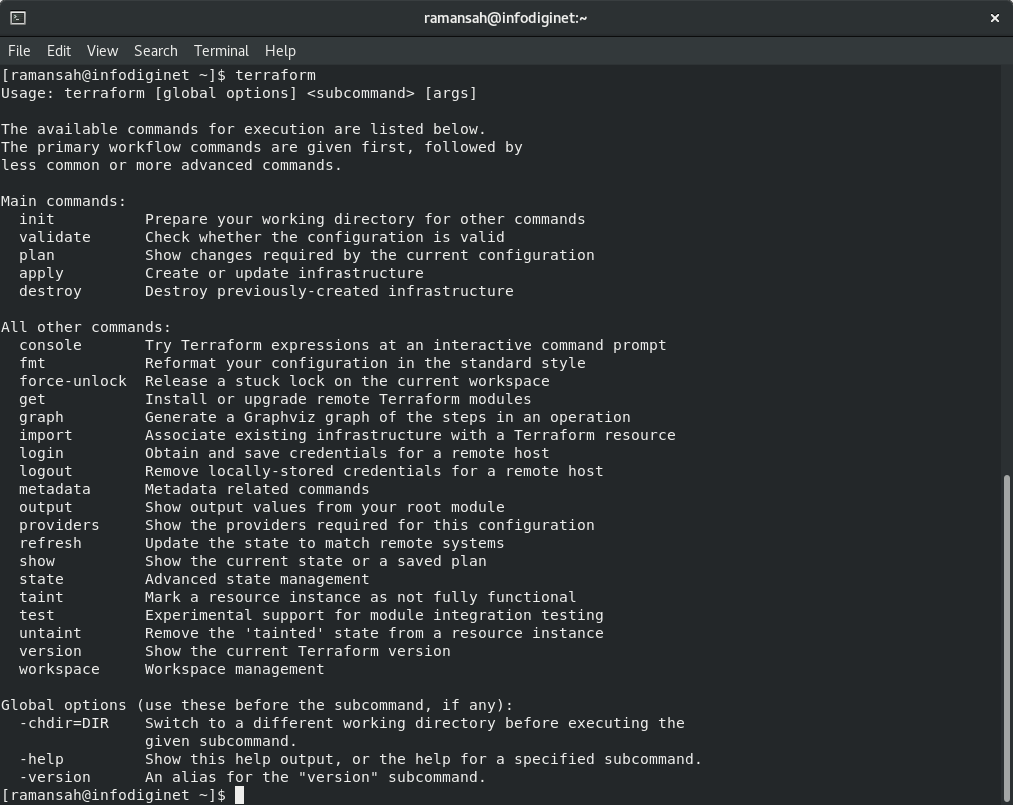How To Install Terraform On Rocky Linux 8
In this short article we will discuss how to install Terraform on Rocky Linux 8 operating system.
Introduction
In today’s rapidly evolving IT landscape, managing infrastructure manually can be time-consuming and error-prone. Terraform, an open-source infrastructure as code (IaC) tool developed by HashiCorp, offers a solution to this challenge. In this article, we will explore what Terraform is, its core concepts, and how it simplifies infrastructure management through automation.
What is Terraform?
Terraform is a powerful tool that allows users to define and provision infrastructure resources using a declarative configuration language. With Terraform, you can describe your desired infrastructure state in code, and the tool will automatically create and manage the resources required to achieve that state. This approach makes infrastructure management more consistent, efficient, and reproducible.
Key Concepts of Terraform
Infrastructure as Code (IaC): Terraform embodies the IaC principle, where infrastructure is managed using code rather than manual processes. This allows for version control, collaboration, and automation.
Providers: Terraform supports various cloud and on-premises providers, such as AWS, Azure, Google Cloud, VMware, and more. Each provider offers a set of resources that can be provisioned and managed using Terraform.
Resources: Resources represent the infrastructure components you want to manage, such as virtual machines, networks, storage, and more. Each resource is defined in the Terraform configuration file.
Terraform Configuration Language (HCL): Terraform uses its own configuration language called HCL (HashiCorp Configuration Language). HCL is designed to be human-readable and allows you to define infrastructure resources, variables, and expressions.
State Management: Terraform maintains a state file that records the current state of the managed infrastructure. The state file is used to plan and apply changes to the infrastructure, ensuring that only necessary modifications are made.Installing Terraform on Rocky Linux 8 Operating System
Installing Terraform on Rocky Linux is a straightforward process. You can use the package manager DNF (Dandified Yum) to install Terraform from the official HashiCorp repository. Here are the steps:
Step 1: Update System Packages
Step 2: Download Terraform Archive File
Step 3: Extract Terraform Archive File And Move It To /usr/local/bin/
Step 4: Verify Terraform Installation
Step 1: Update System Packages
Before installing any new software, it’s a good practice to update the system packages. Open a terminal and run the following command:
$ sudo dnf update
Step 2: Download Terraform Archive File
By using wget command, we will download the latest Terraform archive file to the system. The latest version of Terraform is version 1.5.3. We will submit the following command :
https://releases.hashicorp.com/terraform/1.5.3/terraform_1.5.3_linux_386.zip
Output :
[ramansah@infodiginet ~]$ wget https://releases.hashicorp.com/terraform/1.5.3/terraform_1.5.3_linux_386.zip --2023-07-25 10:21:41-- https://releases.hashicorp.com/terraform/1.5.3/terraform_1.5.3_linux_386.zip Resolving releases.hashicorp.com (releases.hashicorp.com)... 13.35.166.58, 13.35.166.61, 13.35.166.16, ... Connecting to releases.hashicorp.com (releases.hashicorp.com)|13.35.166.58|:443... connected. HTTP request sent, awaiting response... 200 OK Length: 19670532 (19M) [application/zip] Saving to: ‘terraform_1.5.3_linux_386.zip’ terraform_1.5.3_linux_386.z 100%[==========================================>] 18.76M 1.64MB/s in 6m 16s 2023-07-25 10:28:06 (51.1 KB/s) - ‘terraform_1.5.3_linux_386.zip’ saved [19670532/19670532]
Step 3: Extract Terraform Archive File And Move It To /usr/local/bin/
Then we will extract Terraform archive file and move it ot /usr/local/bin directory, by submitting command line :
$ sudo unzip terraform_1.5.3_linux_386.zip
Output :
[ramansah@infodiginet ~]$ sudo unzip terraform_1.5.3_linux_386.zip Archive: terraform_1.5.3_linux_386.zip inflating: terraform [ramansah@infodiginet ~]$ sudo mv terraform /usr/local/bin/
Step 4: Verify Terraform Installation
After the installation is complete, verify that Terraform is installed correctly by checking its version:
$ terraform -v
Output :
[ramansah@infodiginet ~]$ terraform -v Terraform v1.5.3 on linux_386
If it wass successfully installed, we will check it by submitting terraform commands as follow :
$ terraform
Output :
[ramansah@infodiginet ~]$ terraform
Usage: terraform [global options] <subcommand> [args]
The available commands for execution are listed below.
The primary workflow commands are given first, followed by
less common or more advanced commands.
Main commands:
init Prepare your working directory for other commands
validate Check whether the configuration is valid
plan Show changes required by the current configuration
apply Create or update infrastructure
destroy Destroy previously-created infrastructure
All other commands:
console Try Terraform expressions at an interactive command prompt
fmt Reformat your configuration in the standard style
force-unlock Release a stuck lock on the current workspace
get Install or upgrade remote Terraform modules
graph Generate a Graphviz graph of the steps in an operation
import Associate existing infrastructure with a Terraform resource
login Obtain and save credentials for a remote host
logout Remove locally-stored credentials for a remote host
metadata Metadata related commands
output Show output values from your root module
providers Show the providers required for this configuration
refresh Update the state to match remote systems
show Show the current state or a saved plan
state Advanced state management
taint Mark a resource instance as not fully functional
test Experimental support for module integration testing
untaint Remove the 'tainted' state from a resource instance
version Show the current Terraform version
workspace Workspace management
Global options (use these before the subcommand, if any):
-chdir=DIR Switch to a different working directory before executing the
given subcommand.
-help Show this help output, or the help for a specified subcommand.
-version An alias for the "version" subcommand.

After the installation process is complete and successful, then we can explore other things to help us understand how Terraform works as a tool for DevOps.
Conclusion
We have successfully installed Terraform on Rocky Linux 8 operating system. With Terraform installed, we can now create, manage, and update infrastructure as code using the Terraform configuration language. Make sure to check for updates to keep our Terraform installation up-to-date with the latest features and bug fixes. Enjoy using Terraform to automate your infrastructure provisioning and management tasks!
